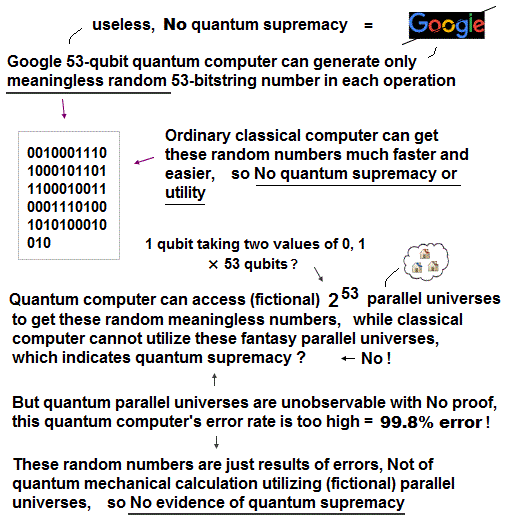
Home page
Google willow fake supremacy
Fake quantum advantage
Quantinuum
Boson sampling
(Fig.1) Quantum supremacy is based on fantasy parallel-universe qubit operations.

Despite extremely long years of researches and exaggerated news, quantum computers are still useless with No practical application.
Today's fake quantum supremacy or advantage can only output random useless numbers called random circuit sampling ( this-3rd-paragraph, this-4th-last-paragraph ) through baseless parallel universe qubits' states that may be hard for a classical computer with a single universe to emulate.
Quantum computers are too error-prone to give right answers (= Google's quantum computers' error or noise rates were more than 99.8%, this-3rd-last-paragraph, this or this-6~12th-paragraphs ), so No real quantum supremacy nor speed-up.
This (or this or this ) 2nd-paragraph says -- Random useless numbers
"The calculation has almost No practical use—it spits out a string of random numbers.... Useful quantum machines are many years away"
This 8th-paragraph says -- Useless quantum supremacy
"Nothing useful in any practical sense — in fact, it is randomly generated, a random quantum circuit"
This website's 5th, 7th paragraphs say -- Just output random numbers
"what the RCS (= random circuit sampling ) benchmark does is sample from the random distribution created by a long string of noisy quantum gates. This algorithm is entirely contrived and useless."
"Google themselves note that RCS is fairly useless, and that they have yet to demonstrate a useful algorithm where Willow outperforms a classical computer."
↑ They insist these random (meaningless) numbers were obtained through 253 (= 53 qubits ) ~ 2105 parallel-universe qubits' superposition states that are hard for classical computers with a single universe to emulate (= so quantum supremacy ? No. )
There is No evidence of these ( fictional ) parallel-universes or superposition (= which cannot be seen nor confirmed ) for quantum computers' supremacy or speed-up.
It means the so-called "quantum supremacy" or "quantum advantage over classical computer" appearing on the media so far is fake, Not faster than a conventional classical computer with No practical use.
↑ Because if quantum computers were really faster or supreme, they should have already replaced the current ordinary computers, which did Not happen.
This 2nd-paragraph says
"IBM readily admits that nobody has yet demonstrated quantum advantage"
Today's quantum computers have only less than 100 qubits (= each qubit can take only 0 or 1 state ), which are still Not computers nor able to calculate anything.
Practical quantum computer for achieving true quantum advantage or supremacy is said to need more than millions of qubits. Google quantum computer had a far smaller number of qubits (= just 53 qubits = just 53 bitstring ) that can Not achieve true quantum supremacy.
This 4th-paragraph says -- Million qubits needed
"For a quantum computer to be practical, millions of qubits must be accommodated on a single chip. The most advanced quantum computers today have only a few hundred qubits, meaning they can only perform calculations that are already possible (and often more efficient) on conventional (= classical ) computers" ← No quantum advantage in today's quantum computers with only small numbers of qubits.
This-8th-last-paragraph says -- Too few qubits
"Willow is still well too small to do useful calculations” and that quantum computers will require millions of qubits to solve really important industry problems. Willow has 105 qubits (= Google sycamore has only 53 useless qubits )."
Quantum supremacy is fake, just outputting random useless numbers with 99.8~99.9% error (= noise ) rates (= XEB fidelity is 0.2% ~ 0.1%, this or this-6~13th-paragraphs, this-p.59 ).
This-middle-Will quantum computers arrive soon ? says
"Google concedes that Willow's error rate is still too high for quantum computing to be useful" ← quantum supremacy is useless, too error-prone.
This-p.3(or p.2)-1st-paragraph says -- Too error-prone
"Google's recent quantum supremacy experiment estimated that their fidelity
was merely ∼0.2% (i.e., the experiment was ∼ 99.8% noise = Google's supremacy experiment's error rate was 99.8% ~ 99.9%, which is results of errors, Not quantum supremacy, this-p.1-lower-willow's XEB fidelity = just 0.1% = 99.9% error rate )"
↑ This too-high error rate shows these random useless numbers are results of errors irrelevant to quantum supremacy based on parallel-universe simultaneous calculations.
↑ But how did physicists estimate the error rate from random meaningless numbers ?
(Fig.N) Fake quantum supremacy just outputting random useless numbers.
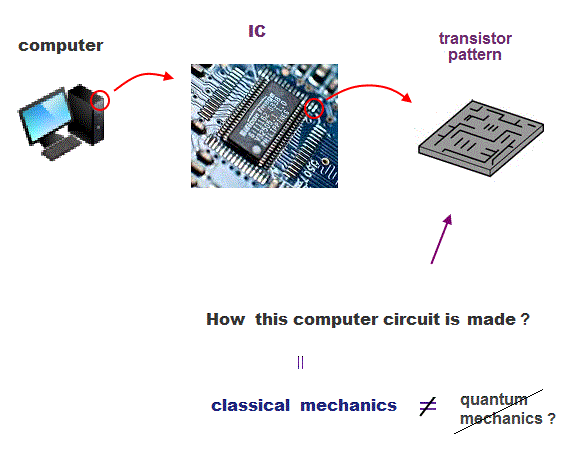
In fact, they already knew the ideal exact answers of probabilities of outputting random numbers even before using ( useless ) quantum computers, so No quantum supremacy from the beginning.
They baselessly say if quantum computer is 100% error rate, it just outputs uniform random meaningless numbers with the probability of outputting each randum number being 1/2n (= n is the qubit's number ), which gives XEB fidelity of 0 (= No quantum supremacy ? )
They assume the ideal exact answer of random number distribution (= when some unseen interference between 2n superposition or parallel-universe states occurs, this-p.2-left-1.1, this-p.19, this-p.1-Quantum speckle ) obeys "Porter-Thomas theory" which gives probability of outputting each random numbers becoming 2/2n ( instead of 1/2n ) which gives XEB fidelity = 1 ( this-p.2-(1), this-p.4-left-1st~2nd-paragraphs, this-p.9, this-p.6, this-p.49 ).
When each random number's probability is 2/2n, the (XEB) fidelity is assumed to be 1 (= they baselessly assumed these random probabilities showed no error rate and quantum supremacy ).
When each random number's probability is purely uniform random = 1/2n (= n is the number of qubits, each qubit can take 2 values of 0 or 1 ), the fidelity is assumed to be 0 (= 100% error rate, so No quantum supremacy ? )
↑ So they already knew the theoretical "right answer or ideal (= slightly-non-uniform ) random number distribution (= Porter-Thomas distribution or random number's probability which value of 2/2n is already known or easily obtained by classical computer or by hand )" before using their (fake) quantum computers with too high error rates, so there was No quantum supremacy from the beginning.
This-middle-Google's quantum supremacy says -- Just random numbers
"This entails performing random operations on the qubits, literally as if the code of their program was chosen randomly"
"The values of all qubits were then measured, and the whole process was repeated multiple times. The resulting distribution is nonrandom due to quantum effects (= parallel-universe or superposition qubits' states ? ) and is exorbitantly challenging to calculate with classical computers."
This (or this ) 8th paragraph say -- Parallel universe interference ?↑ So they baselessly consider the slightly-non-uniform random meaningless numbers as a sign of (illusory) quantum supremacy based on interference among (fictional) 2n (= n is the qubit's number ) quantum superposition or parallel world qubit-states ( this-middle, this-p.3-middle , this-p.1-quantum speckle pattern ).
↑ The fact is Google or other error-prone quantum machines just output the slightly- non-uniform random numbers due to their errors or other reasons (= related to their instruments or classical microwave interference ) irrelevant to the fictional quantum superposition or parallel universes.
Because they cannot distinguish non-uniform errors (= intentionally mistaken for quantum supremacy ) from uniform errors (or random numbers ).
So No evidence of quantum computer's speed-up nor supremacy.
(Fig.Q) A superconducting (= transmon) qubit is just a classical circuit where two different electric currents represent 0 and 1 bit states.
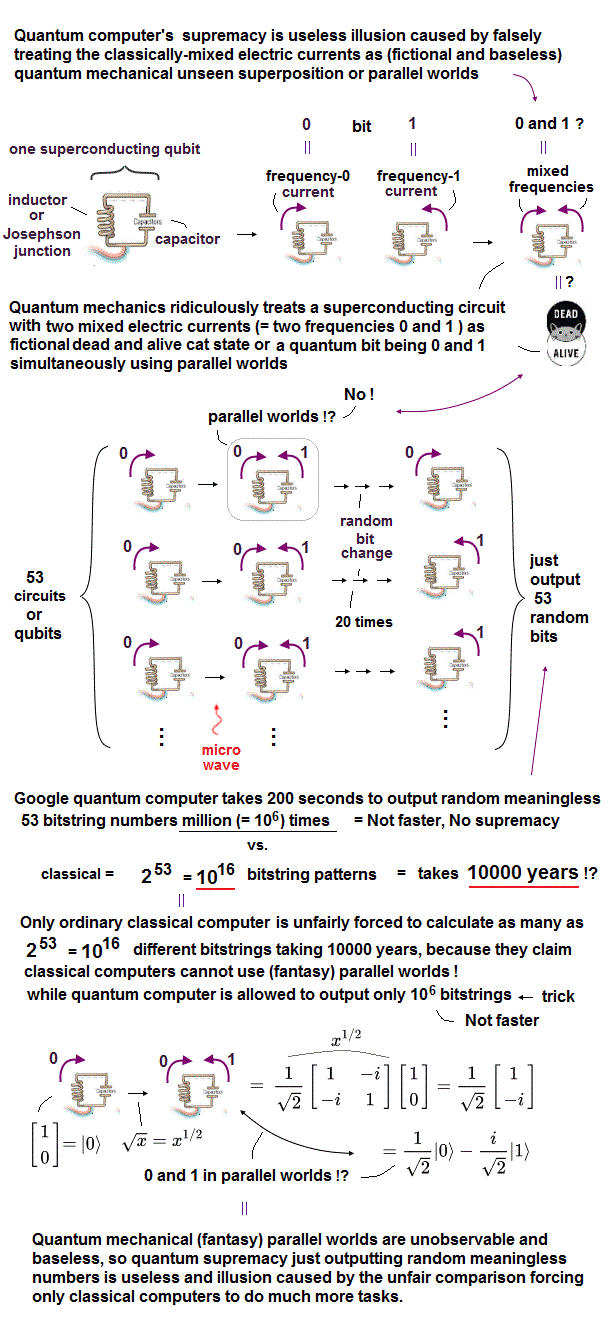
Today's unrealistic quantum mechanics says the quantum computer could output random (meaningless) numbers through (unseen, unfounded) multiple quantum superposition (= a dead and alive cat ) states or fantasy parallel worlds that cannot be emulated by a classical computer using only single world ( this 6-7th paragraphs, this-middle-superpositions; where they go ? ).
↑ No evidence of quantum superposition nor parallel worlds, because they can observe only one state in one single world, when measuring the qubit states ( this 5th-paragraph, this 4~5th-paragraphs ).
↑ They baselessly claim Google 53-qubit quantum computer got random (meaningless) numbers through (unseen) 253 different parallel world (= superposition ) states (= one qubit takes 0 and 1 × 53 qubits ) while 53 qubits were randomly flipped ( this 5th-paragraph, this 4th-paragraph ).
This 6~7th paragraph says
"We performed a fixed set of operations that entangles 53 qubits into a complex superposition state... preparing this superposition state is accomplished by applying a sequence of tens of control pulses to each qubit" ← just applying (classical) microwave pulses to qubits, No evidence of (unobservable) quantum superposition or parallel universes.
"For classical computers, it is much more difficult to compute the outcome (= just random numbers ) of these operations because it requires computing the probability of being in any one of the 2^53 possible (= superposition ) states, where the 53 comes from the number of qubits"
This (or this ) 8th paragraph say
"Sycamore's aim was to randomly produce strings of 1's and 0's, one digit for each qubit, producing 253 bit strings"
Google quantum computer used a (classical) superconducting circuit's electric current state as a qubit 0 or 1 (or the middle state classically-mixing currents treated as illusory superposition ) state that can be manipulated by (classical) microwave ( this p.2-right ).
Despite No evidence, they say these 53 qubits flipped randomly by microwave created (imaginary) quantum superposition or 253 parallel world states until one random number was measured.
An ordinary classical computer was unfairly forced to imitate the unseen unfounded superposition of 253 parallel worlds, and could outperform the Google quantum computer after all.
So there is No quantum supremacy not only from the beginning but also officially ( this 4th-paragraph ).
Today's quantum computers are too error-prone to give right answers, which means there was No quantum supremacy nor advantage over classical computers from the beginning, because an ordinary classical computer can always give right errorless numbers.
↑ If today's error-prone quantum computers cannot give right answers, it is impossible to prove quantum computers actually utilize (unseen) quantum superposition or parallel world states to get right final answers.
This 2nd-last-paragraph says --
Google cannot correct errors
"The Google computer also lacks the ability to correct errors"
So some physicists tried to make the error-prone quantum computers output random meaningless numbers into which a lot of errors are hidden for claiming fake quantum supremacy.
↑ Because random meaningless numbers remain random, no matter how many errors they contain.
The estimated error rate of Google 53-qubit quantum computer outputting random numbers after about 20 cycles of randomly flipping qubits was 99.8%, which means fidelity (= 1 - error rate ) was just 0.2% ( this p.8, this p.3-right, this p.16 ).
This p.3(or p.2)-1st-paragraph says
Google's 99.9% error rate
"Google's recent quantum supremacy experiment estimated that their fidelity
was merely ∼0.2% (i.e., the experiment was ∼~99.8% noise = 99.8% error rate )" ← Google quantum computer just output errors.
This 9th-paragraph says
"Google's computations on Sycamore were Not very precise, achieving a fidelity of just 0.2 percent"
(Fig.E) Today's quantum computers are too error-prone to give right answers. so No true quantum supremacy.
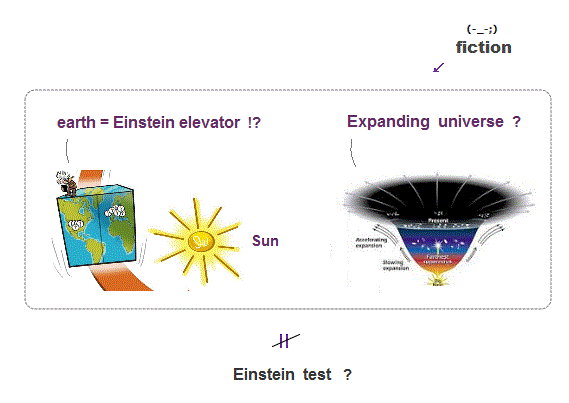
The recent Google's 105-qubit willow and Quantinuum's 56 qubits outputting random meaningless numbers as (fake) quantum supremacy contained impractically many errors of 99.9% and 65% high error rates.
↑ Today's error-prone quantum computers unable to give right answers can only output random useless numbers as fake quantum supremacy, which is far from quantum supremacy or advantage over errorless classical computers.
Even the latest Quantinuum or JP-Morgan's 56-ion-qubit still could only output random useless numbers with too high error rate.
↑ This latest Quantinuum's estimated error rate of outputting (useless) random 56-bit numbers was as high as 68% (= XEB fidelity [= 1 - error rate ] was 32% or 0.32, this-p.4-Table.1-last, Google Willow's error rate was hopelessly high = 99.9% with only 0.1% XEB fidelity, this-p.1-lower, this or this-6~12th-paragraphs ).
So all these (fake) quantum supremacy experiments just outputting random useless numbers full of errors cannot obtain right answers nor prove quantum supremacy.
↑ These random useless numbers were just results of errors (= Not true random numbers nor practical use ), Not of quantum mechanical (faster ?) simultaneous illusory parallel-universe calculations.
They try to use misleading expressions such as "(fake) true random numbers" or "certified random numbers" to hide the inconvenient fact that today's error-prone quantum computers remain useless, deadend, No progress ( this or this-2nd-paragraph ) from 2018.
Ordinary classical computers also can output various kinds of random numbers much faster, so there is No quantum supremacy nor quantum computer's practical use in just outputting random meaningless numbers.
This or this-6~11th paragraphs say
"The point where quantum computers overtake classical ones is known as "quantum supremacy, but achieving this milestone in a practical way would need a quantum computer with millions of qubits. The largest machine today has only about 1,000 qubit (= so today's Google, Quantinuum's less than 100 qubits can Not achieve true quantum supremacy )"
"The team tested the fidelity of H2-1's output using what's known as the linear cross entropy benchmark (XEB = fidelity )"
"They registered an XEB result of approximately 0.002 (= fidelity = 1- error rate ) with the 53 superconducting qubits built into Sycamore (= Google 53-qubit quantum computer's error rate was 99.8% )."
"Quantinuum scientists — achieved an XEB score of approximately 0.35 (= fidelity ). This means the H2 quantum computer can produce results without producing an error 35% of the time (= 65% error rate ). "
↑ It means the random meaningless numbers of Google supremacy experiment was just the result of errors, Not of quantum mechanical calculations based on (unseen) quantum superposition, so No evidence of quantum supremacy.
It is impossible to know and certify actual error rates or fidelity (= 1 - error rate ) only from random meaningless numbers, because errors themselves are caused by unpredictable factors.
Actual error rates of today's error-prone quantum computers are much worse than these 68% (= Quantinuum )~ 99.9% (= Willow ), because XEB fidelity used for roughly guessing error rates of random meaningless numbers overestimates the fidelity (= actual error rates were much worse than XEB value, this-p.20-Fig.10, this-p.9-left-1st-paragraph ).
XEB fidelity just baselessly guesses some non-uniform unspecific random numbers as an evidence of (illusory) quantum supremacy (= quantum superposition parallel universe interference might increase chances of getting some random numbers, which might deviate from uniform random numbers treated as 100% error rate, this-p.2-left, this-2-right~p.3 ).
↑ So all the (fake) quantum supremacy experiments did Not compare (random number) results with the exact value, instead, they just vaguely (= falsely ) estimated the error rates (= 1 - XEB fidelity ) by seeing if the obtained random numbers are uniform (= XEB fidelity = 0, error rate = 100% ) or non-uniform (= XEB fidelity = 1, error rate = 0% = fake quantum supremacy ).
↑ So this XEB fidelity falsely treats non-uniform erroneous numbers as (fake) quantum supremacy with low error rates.
This-4th-paragraph says
"Each run of a random quantum circuit on a quantum computer produces a bitstring, for example 0000101. Owing to quantum interference (= just baseless imagination ), some bitstrings are much more likely to occur than others (= just these non-uniform random numbers are falsely treated as quantum supremacy )"
(Fig.F) Just outputting random numbers of only Nq = 35 qubits (= just 35 bitstring ) caused too high error rates of more than 70% (= XEB fidelity is less than 0.3 ).
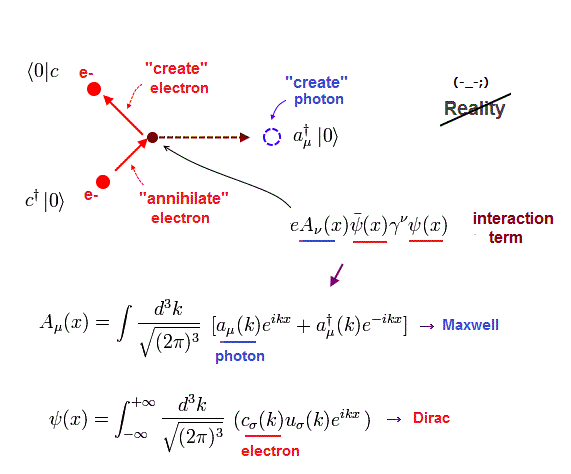
Even Google's latest research can only output random useless numbers of only 35 qubits with more than 70% error rates (= No error correction ) in fake quantum supremacy experiments.
This-7~8th-paragraphs (4/21/2025) say
"We benchmarked the performance of our new analog calibration technique using an experiment known as random circuit sampling (= just outputting random useless numbers ). Specifically, we used the analog evolution to reach a chaotic (= random ) quantum state, i.e., a superposition (= illusory parallel universes ) of all the possible sequences of bits that contain equally many 1s as 0s"
"it showed that our analog simulator reaches the chaotic (= random bitstring ) state very quickly, allowing us to access very complex.. it showed that the measured distribution agreed very well with the theoretically predicted one (= this exact classically-predicted theoretical one is the final goal, so No quantum supremacy ),.. we determined that the chance of making an error was only 1/1000 each time a 1 moves from one qubit to another."
↑ Each one qubit operation caused the high error rate of 1/1000 (= with No error correction ), which cannot give right answers ( this-3rd-last-paragraph ).
↑ This-Google's latest paper-p.2-Fig.2c shows just flipping Nq = 35 qubits 35 times (1/g) caused too high error rate of more than 70%. ← XEB fidelity (= 1 - error rate, this or this-8th~12th-paragraphs ) is less than 0.3.
This-p.7-right-3rd-paragraph says Nq is from (just) 12 to 35 qubits (= still Not a computer ).
This-p.3-left-2nd-paragraph says "an error rate of ϵ = 0.10 ± 0.02% per qubit per
evolution time of 1/g (one cycle = one qubit flip cycle )", which is too high error rate, and No error correction conducted.
This-Google's latest paper's p.2-Fig.2-left says ideal Porter-Thomas distribution (= easily calculated by classical computers ) used as the ideal exact answers for estimating (randomly-flipped) qubits' error rates (= 1 - XEB fidelity ), which means No quantum supremacy over the exact ideal classical computer's result.
As a result, quantum supremacy is fake, just outputting random useless numbers with too high error rates.
See quantum advantage is fake.

Feel free to link to this site.